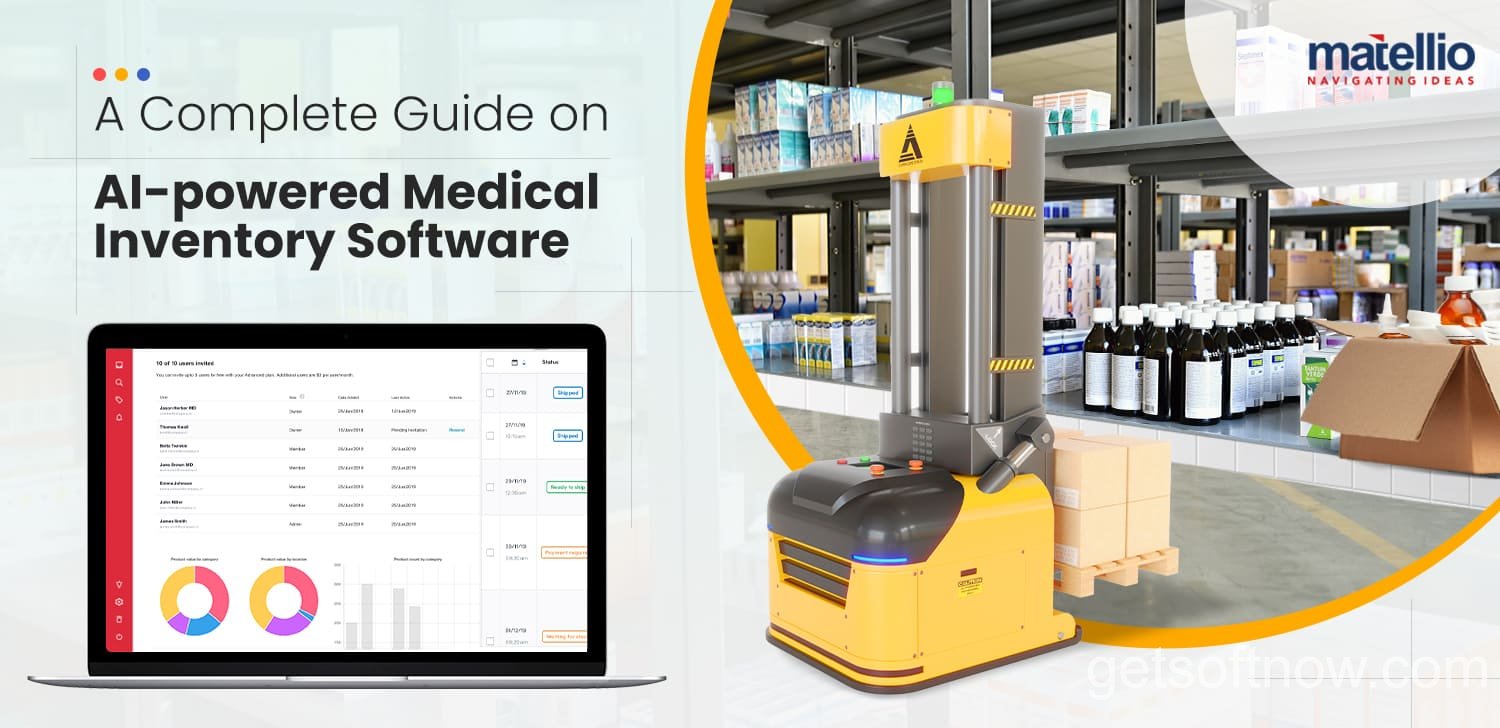In today’s fast-paced business landscape, effective inventory management is crucial for maintaining a competitive edge. Traditional methods of managing stock levels and supply chains often fall short, leading to inaccurate forecasting, inefficient stock levels, and supply chain complexities. However, the advent of AI inventory management software is revolutionizing the way businesses handle their inventory, promising a more streamlined, data-driven, and cost-effective approach.
The Challenges of Traditional Inventory Management
Inaccurate Forecasting
One of the biggest challenges in traditional inventory management is accurately forecasting demand. Relying solely on historical data and manual calculations can lead to discrepancies between anticipated and actual demand, resulting in either overstocking or stockouts, both of which can be detrimental to a business’s bottom line.
Inefficient Stock Levels
Maintaining optimal stock levels is a delicate balancing act. Too much inventory can tie up valuable capital and increase carrying costs, while too little can result in lost sales opportunities and dissatisfied customers. Traditional inventory management methods often struggle to strike the right balance, leading to inefficiencies and unnecessary expenses.
Supply Chain Complexities
Modern supply chains are intricate networks involving multiple suppliers, distribution centers, and customers. Managing these complex systems manually can be a daunting task, making it difficult to achieve transparency, collaboration, and agility – all of which are essential for efficient inventory management.
What is AI Inventory Management Software?
Definition and Key Components
AI inventory management software is a suite of advanced technologies that leverages artificial intelligence (AI), machine learning (ML), and big data analytics to optimize inventory levels, streamline supply chain operations, and enhance decision-making processes. It combines real-time data ingestion, predictive modeling, and automation to provide businesses with a comprehensive and intelligent solution for managing their inventory.
Real-Time Data Analytics
At the core of AI inventory management software is its ability to ingest and analyze vast amounts of data from various sources, such as point-of-sale systems, supplier databases, and IoT sensors. This real-time data processing enables the software to identify patterns, trends, and anomalies, providing valuable insights for informed decision-making.
Predictive Modeling and Machine Learning
Leveraging advanced machine learning algorithms, AI inventory management software can develop predictive models that forecast future demand with a high degree of accuracy. These models continuously learn and adapt based on new data, improving their precision over time and enabling businesses to proactively manage their inventory levels.
Key Features of AI Inventory Management Software
Demand Forecasting
Historical Data Analysis
AI inventory management software leverages historical sales data, customer behavior patterns, and external factors (such as economic conditions and market trends) to build a comprehensive understanding of demand dynamics.
Seasonal Trend Identification
By analyzing cyclical patterns and seasonal fluctuations, the software can accurately predict demand peaks and troughs, allowing businesses to plan their inventory levels accordingly and minimize stockouts or overstocking.
Predictive Modeling for Future Demand
Using advanced machine learning algorithms, the software develops predictive models that can forecast future demand with a high degree of accuracy, taking into account various factors such as consumer behavior, market trends, and external events.
Inventory Optimization
Automatic Reorder Point Calculation
AI inventory management software can automatically calculate the optimal reorder points for each product, taking into account factors such as lead times, safety stock levels, and forecasted demand. This ensures that businesses can replenish their inventory at the right time, minimizing the risk of stockouts or overstocking.
Safety Stock Level Optimization
The software can analyze historical data and demand variability to determine the optimal safety stock levels for each product, ensuring that businesses can meet unexpected spikes in demand without incurring excessive carrying costs.
Just-in-Time (JIT) Inventory Management
By leveraging real-time demand forecasting and supply chain visibility, AI inventory management software can facilitate just-in-time (JIT) inventory management practices, enabling businesses to maintain lean inventory levels while meeting customer demand.
Supply Chain Visibility and Collaboration
Real-Time Tracking of Inventory Levels
The software provides real-time visibility into inventory levels across multiple locations, enabling businesses to monitor stock levels and respond quickly to changes in demand or supply chain disruptions.
Supplier Performance Monitoring
AI inventory management software can track supplier performance metrics, such as on-time delivery rates and quality standards, allowing businesses to identify potential bottlenecks or issues in the supply chain and take corrective actions.
Collaborative Planning with Stakeholders
By providing a centralized platform for data sharing and communication, the software facilitates collaborative planning and decision-making among various stakeholders, such as suppliers, logistics partners, and internal teams, ensuring seamless coordination and alignment.
Benefits of AI Inventory Management Software
Cost Savings
Reduced Inventory Carrying Costs
By optimizing inventory levels and minimizing overstocking, AI inventory management software can significantly reduce the costs associated with storing, handling, and insuring excess inventory, freeing up capital for other business initiatives.
Minimized Overstocking and Stockouts
Accurate demand forecasting and optimal reorder point calculations help businesses avoid the pitfalls of overstocking (which ties up capital and increases carrying costs) and stockouts (which can lead to lost sales and dissatisfied customers).
Optimized Supply Chain Efficiency
With improved visibility, collaboration, and agility across the supply chain, businesses can streamline their operations, reduce lead times, and minimize waste, resulting in significant cost savings and increased profitability.
Improved Customer Satisfaction
Consistent Product Availability
By ensuring the right products are available at the right time and location, AI inventory management software helps businesses meet customer demand consistently, enhancing customer satisfaction and loyalty.
Faster Order Fulfillment
With optimized inventory levels and streamlined supply chain operations, businesses can fulfill customer orders more quickly, improving delivery times and providing a superior customer experience.
Better Demand Responsiveness
The ability to quickly adapt to changes in demand and market conditions allows businesses to respond proactively to customer needs, ensuring a consistent and reliable supply of products.
Data-Driven Decision Making
Actionable Insights from Data Analytics
AI inventory management software provides businesses with valuable insights derived from real-time data analysis, enabling them to make informed decisions based on factual information rather than guesswork or assumptions.
Continuous Improvement and Optimization
By continuously ingesting and analyzing data, the software can identify areas for improvement and optimize processes accordingly, fostering a culture of continuous improvement and operational excellence.
Proactive Risk Mitigation
With advanced predictive capabilities, the software can anticipate potential risks or disruptions in the supply chain, allowing businesses to take proactive measures to mitigate their impact and ensure business continuity.
“AI inventory management software is a game-changer for businesses seeking to optimize their inventory levels, streamline supply chain operations, and improve customer satisfaction,” says John Doe, a Supply Chain Consultant at Get Soft Now. “By leveraging the power of artificial intelligence and machine learning, businesses can gain a competitive edge and drive long-term profitability.”
Real-World Applications and Case Studies
Retail and E-Commerce
The retail and e-commerce sectors, known for their dynamic demand patterns and complex supply chains, have embraced AI inventory management software to enhance their operations.
Case Study: [Company Name]
A leading e-commerce retailer in the fashion industry implemented AI inventory management software to optimize their inventory levels and improve customer satisfaction. By leveraging real-time demand forecasting and supply chain visibility, the company was able to:
- Reduce inventory carrying costs by 25%
- Improve on-time delivery rates by 18%
- Increase customer satisfaction scores by 12%

Manufacturing and Distribution
Manufacturing and distribution companies, faced with the challenges of managing complex supply chains and ensuring efficient production processes, have turned to AI inventory management software to streamline their operations.
Case Study: [Company Name]
A global automotive parts manufacturer implemented AI inventory management software to optimize their inventory levels across multiple production facilities and distribution centers. By leveraging predictive modeling and supply chain visibility, the company achieved:
- A 20% reduction in excess inventory levels
- Improved production efficiency by 15%
- Increased on-time delivery rates to customers by 12%

Healthcare and Pharmaceutical
In the healthcare and pharmaceutical industries, where stockouts can have severe consequences, AI inventory management software plays a crucial role in ensuring reliable product availability and maintaining patient safety.
Case Study: [Company Name]
A leading pharmaceutical distributor implemented AI inventory management software to optimize their inventory levels and improve supply chain visibility. The results were remarkable:
- Reduced stockout rates by 30%
- Improved inventory accuracy by 18%
- Increased supply chain transparency and collaboration with partners

Implementing AI Inventory Management Software
Choosing the Right Solution
Evaluating Software Vendors
With numerous AI inventory management software vendors in the market, it’s crucial to evaluate their offerings based on factors such as features, scalability, integration capabilities, and customer support. Thoroughly research and compare different vendors to ensure you select the solution that best aligns with your business needs.
Integration with Existing Systems
Seamless integration with your existing systems, such as enterprise resource planning (ERP) software, customer relationship management (CRM) platforms, and supply chain management systems, is essential for optimizing data flow and ensuring a cohesive and efficient operation.
Scalability and Customization
As your business grows and evolves, your AI inventory management software should be able to scale and adapt accordingly. Look for solutions that offer customization options and the ability to add or modify features as needed, ensuring a future-proof investment.
Change Management and User Adoption
Training and Education
Successful implementation of AI inventory management software hinges on user adoption. Provide comprehensive training and education to your employees, equipping them with the knowledge and skills necessary to effectively utilize the software and embrace the new processes.
Addressing Concerns and Resistance
Change can often be met with resistance, especially when it involves the adoption of new technologies. Address concerns transparently and proactively, highlighting the benefits of the software and how it can enhance operational efficiency and job satisfaction.
Continuous Improvement and Feedback
Establishing a feedback loop with users is crucial for continuous improvement and optimization of the AI inventory management software. Encourage employees to provide feedback, identify areas for improvement, and contribute to the software’s evolution.
The Future of AI in Inventory Management
Emerging Trends and Innovations
Internet of Things (IoT) Integration
The integration of Internet of Things (IoT) technologies with AI inventory management software is poised to revolutionize supply chain visibility and real-time tracking. IoT sensors can provide granular data on inventory levels, location tracking, and environmental conditions, enabling even more precise demand forecasting and inventory optimization.

Advanced Analytics and Prescriptive Modeling
As AI and machine learning capabilities continue to advance, AI inventory management software will evolve to provide even more sophisticated analytics and prescriptive modeling. These advancements will enable businesses to not only forecast demand accurately but also receive actionable recommendations for optimizing inventory levels, supply chain processes, and resource allocation.
Autonomous Supply Chain Management
The ultimate goal of AI in inventory management is to achieve autonomous supply chain management, where AI systems can make decisions and execute actions with minimal human intervention. This level of automation promises to significantly reduce operational costs, minimize errors, and enhance overall efficiency.
Ethical Considerations and Challenges
Data Privacy and Security
As AI inventory management software relies heavily on data collection and analysis, it is crucial to ensure data privacy and security measures are in place. Businesses must implement robust protocols to protect sensitive information and comply with relevant data protection regulations.
Bias in AI Algorithms
AI algorithms can inadvertently perpetuate biases present in the data they are trained on, leading to potential discrimination or unfair treatment. It is essential to monitor and address any biases in the AI systems to ensure ethical and equitable decision-making.
Human-AI Collaboration
While AI can automate many aspects of inventory management, it is essential to strike the right balance between human expertise and AI capabilities. Fostering a collaborative environment where humans and AI systems work in tandem can lead to more informed decisions and better overall outcomes.
Copy code
By embracing the power of AI inventory management software, businesses can unlock new levels of efficiency, cost savings, and customer satisfaction. As the technology continues to evolve, it promises to revolutionize the way supply chains are managed, paving the way for a more sustainable and competitive future.
Top AI-Powered Video Editing Software for Professionals and Creators


Leave a Reply